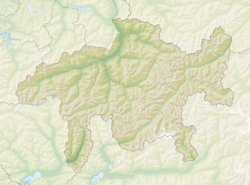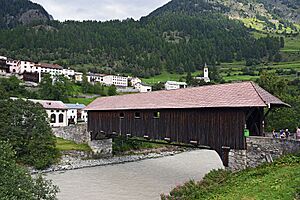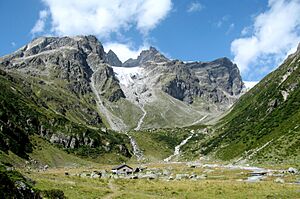Lavin facts for kids
Quick facts for kids
Lavin
|
||
|---|---|---|
 |
||
|
||
| Country | Switzerland | |
| Canton | Graubünden | |
| District | Inn | |
| Area | ||
| • Total | 46.18 km2 (17.83 sq mi) | |
| Elevation | 1,412 m (4,633 ft) | |
| Population
(Dec 2014)
|
||
| • Total | 221 | |
| • Density | 4.786/km2 (12.395/sq mi) | |
| Postal code |
7543
|
|
| Surrounded by | Ardez, Gaschurn (AT-8), Guarda, Klosters-Serneus, Susch, Zernez | |
Lavin was once a small town, or municipality, in the Swiss region of Graubünden. It was located in the Inn area. On January 1, 2015, Lavin joined with another town called Susch. Together, they became part of the larger municipality of Zernez.
Contents
A Glimpse into Lavin's Past
Lavin is quite old! We first hear about it in writings from the 12th century. Back then, it was known by a slightly different name, Lawinis.
Where is Lavin?
Lavin covers an area of about 46.2 square kilometers (about 17.8 square miles). Imagine a place where nature is all around!
- A big part of the land, almost 20%, is used for farming.
- Another 18% is covered by forests.
- Only a tiny bit, less than 1%, has buildings or roads.
- The largest part, over 60%, is made up of mountains, rivers, or glaciers. This means it's a very natural and wild place.
Lavin is located on the left side of the Inn River. It's known as a linear village, which means its buildings are spread out along a road or river.
Who Lives in Lavin?
In 2014, about 221 people lived in Lavin. A small number of these residents, about 8.5%, were from other countries. Over the past ten years, the number of people living in Lavin has slowly grown.
The people of Switzerland are generally well-educated. In Lavin, most adults (about 87.7%) have finished high school or gone on to higher education, like university.
Lavin has a very low unemployment rate, meaning most people who want to work have jobs.
- About 20 people work in farming.
- A few people work in manufacturing.
- Around 50 people work in services, like shops or tourism.
Here's how the population of Lavin has changed over many years:
| year | population |
|---|---|
| 1835 | 359 |
| 1850 | 367 |
| 1900 | 249 |
| 1950 | 242 |
| 1970 | 155 |
| 1990 | 184 |
| 2000 | 174 |
What Languages are Spoken?
Most people in Lavin speak Rhaeto-Romance, which is a very old local language. In 2000, about 76% of the people spoke Romansh. The second most common language is German, spoken by about 23% of the population. A small number of people also speak Portuguese.
Even though German speakers have been in Lavin for a long time, most people still speak the local Romansh dialect called Vallader. While the number of Romansh speakers has gone down a little over the years, most people in Lavin still understand it.
| Languages | Census 1980 | Census 1990 | Census 2000 | |||
|---|---|---|---|---|---|---|
| Number | Percent | Number | Percent | Number | Percent | |
| German | 33 | 18.13% | 38 | 20.65% | 40 | 22.99% |
| Romanish | 147 | 80.77% | 145 | 78.80% | 132 | 75.86% |
| Population | 182 | 100% | 184 | 100% | 174 | 100% |
Important Historical Sites
The old, empty village of Gonda is a very special place near Lavin. It's considered a heritage site of national significance in Switzerland. Gonda was first mentioned around 1160, but by the 1600s, everyone had left it. In 1983, the village was carefully restored so people can still visit and see what it was like long ago.
See also
 In Spanish: Lavin para niños
In Spanish: Lavin para niños







